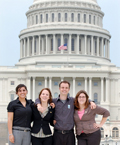
Briana Morrison, a landscape architecture student in Texas A&M’s College of Architecture, believes landscape architects can make major contributions to the preservation of the nation’s historic sites as well as its energy conservation efforts through national legislation.
She and three like-minded Aggie landscape architecture students, M’Lynn Lehrmann, Paul Cozzolino, and Pamela Humphrey, journeyed to Washington D.C. May 8 to lobby members of the U.S. Congress as part of ASLA’s Lobby Day. They were sponsored by the college’s landscape architecture and urban planning department and the ASLA.
“Going there was a really good experience as a student because we were treated as if we were already professionals,” Morrison said. “There was no special treatment because we were students. I think we have a lot more faith in what we’re doing in our major and what we’ve been learning in school; it really reinforces everything we’ve been learning.”
The students were part of a giant effort to blanket Capitol Hill with professional and student landscape architects lobbying for causes important to the ASLA.
Securing funding for the Historic American Landscapes Survey is at the top of ASLA’s agenda in the current legislative session. HALS is a U.S. National Park Service program that documents historic places through measured drawings, archival photographs and written reports.
“Several legislators share ASLA’s concern for documenting and preserving historic landscapes and agreed to work toward funding the program,” said a May 20 press release from the ASLA.
On Lobby Day, the four Texas A&M students spoke with a member of Senator Kay Bailey Hutchinson’s staff during a weekly coffee in her office. Then they went to Senator John Cornyn’s office and spoke with a member of his staff who turned out to be a Texas A&M former student, who they spoke with for about 90 minutes. Lastly, they met with U.S. Rep. Chet Edwards for about half an hour.
Morrison and her group also talked to congressional representatives about the importance of two other bills—H.R. 1716, The Green Energy Education Act, and H.R. 5867, the Energy Conservation through Trees Act.
Going green is also of great importance to Morrison.
“Everyone’s talking about this, but how do you actually get it started, how do you actually make change happen?“ asked Morrison. “Something my studio always talked about was, well, this is something we really believe in, and its’ something we really want to happen, but how do we get other people to believe this also?”
She found the halls of Congress to be a good place to start. “What I figured out by going to D.C. is you really have to do it yourself. You have to get up there and say ‘this is important’ to make people listen to you,” she said.
The ASLA began preparing them for their lobbying effort well ahead of the trip.
“We had to ‘attend’ Web seminars where they explained the bills in depth,” said Morrison. “On the ALSA advocacy network page you could read the bill and learn all about it, learn about your representative, so you could try to get an edge when you talked to them.”
The training continued when they got to the nation’s capital.
“When we got to D.C., there was a three-hour training session on how to lobby. We practiced lobbying and we got packs of material with talking points. It was great. They did a really good job preparing us.”
There wasn’t much time to sightsee, but Morrison and her fellow ASLA students did get a chance to take in the sights on the National Mall.
“The first night after the training, all the ASLA students were invited to a dinner and then we walked from the Capitol building down the mall to the Washington Monument,” she said. “Then we continued on to the World War II Memorial, then we went up to the Vietnam Veterans Memorial, and walked back to our hotel on Capitol Hill.”
One of the highlights of Morrison’s trip was being surrounded by her peers, as well as the many ASLA professionals in town for Lobby Day.
“If I hang out with people who are not in landscape architecture, and I walk down the street, and I go ‘Wow, look at that planter design,’” she said sometimes she might get a puzzled reaction.
“When we were in D.C. and you say something like that, everyone stops and looks and is like, ‘Oh, wow, what is that, slate?’ and you’re thinking, these are people just like me, it’s amazing,” she said.
Taking in the streets of the nation’s capital with landscape architecture-trained eyes was an experience for Morrison as well.
“The whole city, the whole layout of it, the locations of all the monuments, is landscape architecture,” she said. “Some of the monuments, landscape architects were involved in; Maya Lin did the Vietnam Veterans Memorial. One of the things I thought was most amazing is that you’re walking around there and the trees are just magnificent. There were plants you’d never see in Texas and everything was just huge. Roses were the size of my fist.”
Something Tom Woodfin, one of her landscape architecture professors, said hit home too.
“He told us in our Landscape Theory class that the mark of a good landscape architect is people don’t know you exist,” she said. “And that was one of the things I noticed about D.C. The plants and trees look like they were always there but it was part of a design.”
The trip had a big effect on Morrison and her fellow students.
“It was sort of eye-opening to see what’s happening in your profession, and I think becoming involved in your profession as a student is important,” she said. “I think we have a lot more faith in what we’re doing in our major and what we’ve been learning. It really reinforced everything we’ve been learning.”




